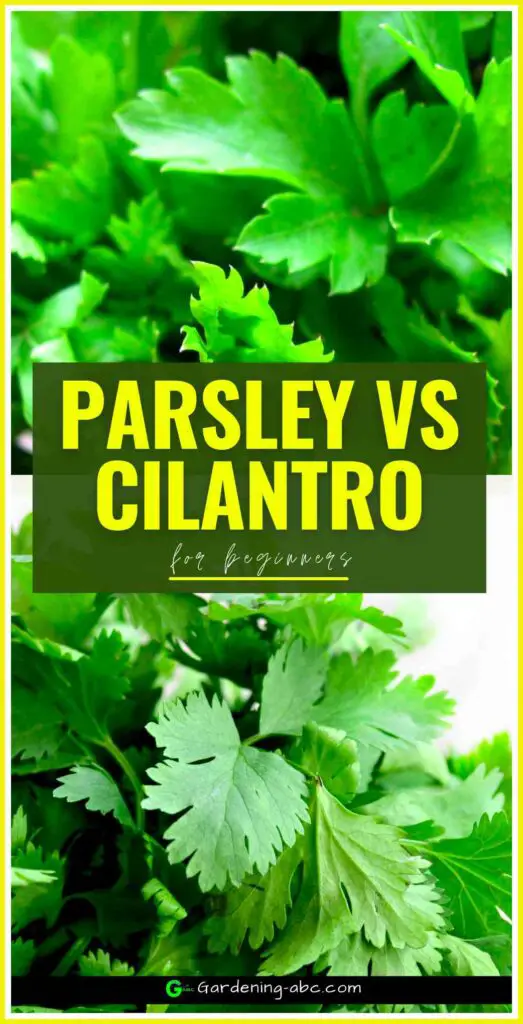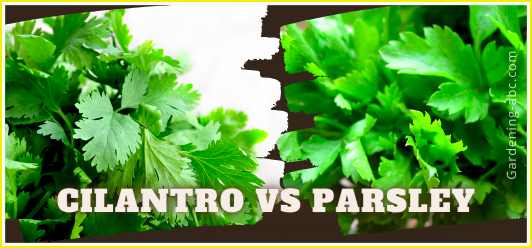We use affiliate links to run our site. When you buy through links on our site, we may earn an affiliate commission, without any added cost to you. Learn more
Parsley and cilantro are two different herbs that look remarkably similar. They are quite common in most kitchens, and herb gardens.
What this means is that people frequently confuse the two herbs and use them interchangeably in recipes (and in life). But simply because parsley and cilantro look similar, doesn’t mean they’re the same thing.
In this post, you’ll learn more about the differences between these two herbs’ stems, leaves, and seeds to help you tell them apart.
While both have the same range of uses, it’s good to know the basic differences between parsley and cilantro. So you know exactly what to use in a particular recipe.
Read on, this will be very interesting.
What is parsley:
Parsley is a leafy green herb that is used in many different dishes. It’s a great addition to salads and soups, or even just eaten on its own as a snack. Parsley is also a popular ingredient in herbal medicine.
It is a biennial herb that is native to the Mediterranean region, where it has been cultivated for thousands of years.
Types of parsley:
There are two main types of parsley:
- Curly leaf parsley, and
- Flat-leaf parsley (also known as Italian parsley).
Curly parsley has leaves that curl around the stem and form a rosette shape. Flat-leaf parsley also has curled leaves but they appear more like blades than rosettes.
Both types have a similar taste but flat-leaf parsley is slightly stronger in flavor than curly parsley.
What Is Cilantro?
Cilantro (Coriandrum sativum) is an herb in the Apiaceae family of plants. Cilantro is most popular for its delicate, bright green leaves.
Cilantro is sometimes called coriander, Chinese parsley, and Mexican parsley in other parts of the world.
The cilantro leaves resemble those of flat-leaf parsley, but the taste is very different from parsley.
Cilantro can be used fresh or dried in many different dishes including salads, soups, sauces, and curries.
What are the basic differences between Parsley and Cilantro:
Parsley and cilantro are two different herbs that have a very similar appearance. They are both green, leafy, and somewhat succulent. They both have a similar aroma and taste, but they also have some notable differences.
Name:
The first thing you will notice is being different plants, they have different botanical names.
Although both cilantro and parsley are from the same botanical family, Apiaceae, they belong to a different genus. and bear different botanical names.
The botanical name of Parsley is Petroselinum crispum whereas the cilantro or coriander is known as Coriandrum sativum.
Appearnace:
Parsley has long, flat leaves attached to thick stems. The leaves grow in a cluster at the top of the plant and are bright green in color.
Cilantro on the other hand has thin stems that grow from the base of the plant, and small leaves that look like ferns.
The serrations on the parsley herb are a bit jagged while the cilantro leaf is somewhat rounded.
Both plants have white flowers that grow into seeds after they bloom. The seeds can be used to make oils that have medicinal properties such as helping digestion and aiding circulation.
Aroma:
The aroma of parsley is earthy, while cilantro has a distinct aroma that resembles citrus fruits such as oranges, limes, or lemons.
The Taste:
While the two herbs appear to be identical, they actually taste quite different.
Parsley tastes peppery and slightly bitter when eaten raw, while cilantro has a milder taste that’s similar to celery or fennel when eaten raw.
Cooked parsley loses its strong flavor and becomes milder, while cooked cilantro retains its unique aroma even after cooking.
Nutrients:
Both cilantro and parsley are naturally low in calories, fat, and sodium. The nutrients in both of them are quite similar with a subtle difference.
Parsley is very rich in Vitamin A and potassium. It also has Vitamin C, calcium, folate (folic acid), and phosphorous in moderate quantities. Parsley is a good source of dietary fiber (1.23 gm dietary fiber to1/2 cup parsley).
Just like parsley, Cilantro is also very rich in Vitamin A and potassium but it is even higher in calcium and dietary fiber than parsley. Cilantro is also moderately rich in Vitamin C and folic acid.
How to distinguish between the two:
Parsley and cilantro are two different herbs that look very similar. You might have seen them confused in recipes or at the grocery store.
If you’re unsure which one to use, here’s how to distinguish between the two:
Look at the leaves. Parsley has flat leaves that grow from a central stem. Cilantro has flat leaves but they are also somewhat serrated along the edges.
If you look closely at the stems, you can see that parsley stems are covered with fine hairs while cilantro stems are smooth and green.
If the plants are side-by-side, it should be easy to distinguish using this method.
Smell the herbs. To test for flavor intensity, rub your thumb on a leaf and smell it. Parsley and cilantro smell very different.
Cilantro smells like anise or fennel when crushed and has hints of citrus as well as minty notes when chewed or cooked. Parsley has a more subtle scent; it may smell like celery.
Look for the label or ask an employee. If the first two methods don’t work for you this will definitely solve the problem.
Can you use cilantro in place of parsley?
Cilantro is not the best option as a replacement for parsley if you are using it in cooking. You can rather use chives that taste more like parsleys.
For garnishing use celery along with cilantro to get the best results.
Having said that there might be some dishes(where you are using parsley as a base) there are no substitutes for parsley.
Can you replace cilantro with parsley?
You can substitute cilantro with parsley just combine it with basil and oregano.
A good alternative for cilantro in many dishes would be mint leaves combined with a bit of lemon.
Can You Grow Cilantro and parsley Together?
Yes, you can grow cilantro and parsley in the same container. Along with the two, you can also add basil, tarragon, and other herbs that have similar needs.
Here is a complete list of plants that grow fantastically well with cilantro.
conclusion:
Hopefully, this guide has helped clear up the confusion that many people have when it comes to identifying parsley vs cilantro.
No matter what particular variety you’re looking for, from either spice or plant, there’s no denying the myriad of benefits that each can offer.
Whether you want a flavorful seasoning for your next dish or an ornamental addition to your garden, there’s something for everyone when it comes to these two amazing plants.
The next time someone asks you “What is the difference between cilantro and parsley?”, you’ll be able to give them a definitive response.
If you like the information, share it with others, and Don’t Forget to PIN IT.
If you want to know more about growing cilantro This post will help you.

Amazon and the Amazon logo are trademarks of Amazon.com, Inc, or its affiliates.

Hi there! My name is Prasenjit and I’m an avid gardener and someone who has grown a passion for growing plants. From my hands-on experience, I have learned what works and what doesn’t. Here I share everything I have learned.
